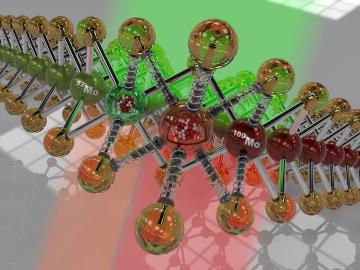Filter News
Area of Research
Date
News Topics
- 3-D Printing/Advanced Manufacturing (7)
- Advanced Reactors (2)
- Artificial Intelligence (14)
- Big Data (4)
- Bioenergy (7)
- Biology (7)
- Biomedical (4)
- Biotechnology (4)
- Buildings (10)
- Chemical Sciences (7)
- Clean Water (3)
- Climate Change (13)
- Composites (3)
- Computer Science (12)
- Critical Materials (1)
- Decarbonization (14)
- Emergency (1)
- Energy Storage (6)
- Environment (15)
- Exascale Computing (2)
- Fossil Energy (2)
- Frontier (3)
- Fusion (3)
- Grid (3)
- High-Performance Computing (10)
- Isotopes (4)
- ITER (1)
- Machine Learning (4)
- Materials (10)
- Materials Science (6)
- Mathematics (1)
- Microscopy (1)
- Nanotechnology (2)
- National Security (8)
- Net Zero (3)
- Neutron Science (6)
- Nuclear Energy (4)
- Partnerships (6)
- Physics (1)
- Polymers (3)
- Quantum Computing (4)
- Quantum Science (8)
- Security (1)
- Simulation (7)
- Space Exploration (2)
- Statistics (1)
- Summit (4)
- Sustainable Energy (10)
- Transportation (8)
Media Contacts

To balance personal safety and research innovation, researchers at ORNL are employing a mathematical technique known as differential privacy to provide data privacy guarantees.

Plans to unite the capabilities of two cutting-edge technological facilities funded by the Department of Energy’s Office of Science promise to usher in a new era of dynamic structural biology. Through DOE’s Integrated Research Infrastructure, or IRI, initiative, the facilities will complement each other’s technologies in the pursuit of science despite being nearly 2,500 miles apart.

ORNL scientists contributed to a DOE technical study that found transitioning coal plants to nuclear power plants would create high-paying jobs at the converted plants and hundreds of new jobs locally.

Groundbreaking report provides ambitious framework for accelerating clean energy deployment while minimizing risks and costs in the face of climate change.

Research led by scientists at ORNL has demonstrated that small changes in the isotopic content of thin semiconductor materials can influence their optical and electronic properties, possibly opening the way to new and advanced designs with the semiconductors.
Luke Bertels, a Eugene P. Wigner Fellow, is helping determine ways to combine artificial intelligence and quantum computing, specifically to develop classical and quantum machine learning methods for using adaptive neural networks to study correlated molecules and chemical systems.

Scientists at the Department of Energy’s Oak Ridge National Laboratory have developed lubricant additives that protect both water turbine equipment and the surrounding environment.

Scientists at Oak Ridge National Laboratory and six other Department of Energy national laboratories have developed a United States-based perspective for achieving net-zero carbon emissions.

The U.S. Environmental Protection Agency has approved the registration and use of a renewable gasoline blendstock developed by Vertimass LLC and ORNL that can significantly reduce the emissions profile of vehicles when added to conventional fuels.

The Quantum Voices series is designed to share the stories of the quantum researchers and technical experts behind the Quantum Science Center’s past, present and future accomplishments. Chengyun Hua is highlighted for this edition, talking about her role in the Quantum Science Center.




